
Jeffrey Colvin’s Africaville is published this month. He shares five books that offer a master class in historical fiction, books that inspired him over the nearly twenty-year period he worked on Africaville.
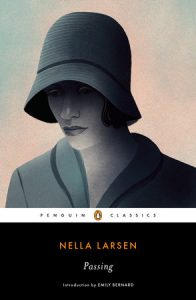
Passing by Nella Larsen
I consulted Nella Larsen’s novel Passing when I was struggling to find the best way to explore how the pull of a small black community like Africaville could affect a family over several generations. I knew what might pull the second and third generation of descendants of the Sebolt family toward cherishing the town where their ancestors lived, particularly the continued efforts by former residents to keep the town’s memory alive after it was demolished. I finally decided that creating a black character light enough to pass as white would be one route to exploring a societal force that might allow subsequent generations to distance themselves from Africaville. Against the backdrop of early twentieth-century Chicago and New York, Larsen brilliantly depicts the complicated lives of characters, light enough to pass for white, the desires and hopes of those who decide not to pass, but most especially the emotional effects of those who do.
Jane Ciabattari: I’ve always been impressed with Larsen’s scene on the rooftop of the Drayton Hotel in Chicago where childhood friends Irene and Clare meet by chance, both passing for white. Irene finds herself wishing to find out from Clare “about this hazardous business of ‘passing,’ this breaking away from all that was familiar and friendly to take one’s chance in another environment, not entirely strange, perhaps, but certainly not entirely friendly.” Larsen makes it clear in this early scene how passing is about class as well as race. How do you think Larsen makes Clare such a distinctive character, a rebel who is always “wanting,” reconnecting with a more conventional Irene?
Jeffrey Colvin: After her visit at the Drayton, away from “the seduction of Clare Kendry’s smile,” Irene walks the hot streets of Chicago with a bevy of conflicted feelings. She is pleased and flattered that Irene was glad to see her, but also irritated that she bothered to reconnect with an old childhood friend who had spurned her for years.
Irene’s frustration begins with the letter from Clare who writes that she longs to see Irene while blaming Irene for causing the longing. Irene agrees to meet, drawn in by Clare’s air of mystery and her bold rebelliousness. Irene remembered that even before Clare’s father, a violent, drunk, had been killed in a bar fight when she was only fifteen, Clare was already steeling herself against the world—whether stealing money from her employer to make a dress to attend a picnic or fighting boys from the neighborhood who dare to taunt her. Irene reconnects with Clare if only to address the many questions she has about Irene’s life. How had Irene been treated by the family she had gone to live with after her father’s death? Were members of that family white or were they colored and also passing? As a young woman, had Irene really been seen often in the company of fashionable, well dressed white men and women?
Clare is an oversized character, a woman who does more than merely visit restaurants and other public places that are nominally whites-only. She marries a white man, a racist who has no idea that she is black. Over the course of the novel, Irene continues to be repelled by Clare’s rebelliousness but at the same time she cannot help but be drawn to Clare’s steely resolve not to be hemmed in by unjust circumstances.
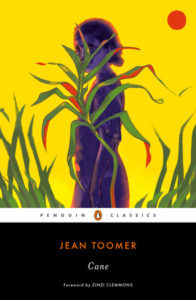
Cane by Jean Toomer
Jean Toomer’s Cane is a book-length mixture of prose, poetry and extended dramatic scenes often classified as a novel. The nontraditional structure was what brought me to the novel. But I soon became enamored with the brilliant contrasts of black life—southern and northern, the wretched and the sublime—and also the emotional power in the scenes. Toomer shows how to bend and shape the structure of a novel to suit the needs of the story.
JC: What formal approaches in Africaville—bending and shaping—were inspired by your reading of Cane?
JC: Reading Cane affected my novel in a way I had not expected. Knowing publishers considered a book with a fractured, non-traditional structure, publishable as a novel was a revelation to me. It allowed me the freedom to experiment with different structures for my novels. Early in the writing of Africaville I experimented with many elements inspired by jazz and blues music from the early twentieth century. I wrote song lyrics and placed them at various points in the first third of the novel. Ultimately these activities helped me deepen the story of one of my characters who is passionate about the blues. Though the lyrics I wrote did not make it into the book, I would not have gotten at this aspect of the character without having experimented with structure. Also, in studying Cane, I learned that though the narrative might seem fractured, it has a basic structure. Cane takes the reader from the southern United States to the north and then back to the south—a thin undergirding for a novel length work, but strengthened with the additional tissue of characters who struggle under early twentieth century racial oppression. The novel’s powerful characters and its emotional offerings mitigate against the tension readers might have as they adapt to the changing prose styles. Although ultimately, I did not mimic the fractured structure of Cane, reading and studying the book helped me explore creative ways into various aspects of my novel.
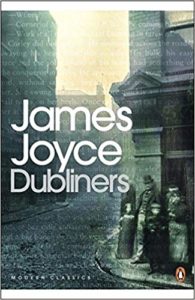
Dubliners by James Joyce
The church plays a central part in the community on which Africaville is based. Reading Joyce, I learned how to incorporate everything from the physical spaces such as churches and altars to the objects used in religious practices. In this collection of short stories set principally in Dublin, Ireland in the early twentieth century, Joyce brilliantly shows how religious beliefs and practices affect how characters interact with family members and others in the community. This work also explores how religion shapes larger societal aspects, from the education of the young to the political views of adults.
JC: Can you give an example of Joyce’s influence on how you presented the church in the Nova Scotian community you write about in your novel? Africaville was based on a real Halifax community, which no longer exists, right? Known as Africville?
JC: I first encountered the church that once existed in the former community of Africville when I watched videos of lively sermons in the church, and also emotional interviews with past members of congregation. These images presented the church as more than a building and hearing about what the church meant to the residents led me to believe this element in the community was more than the building. The “church” of the former Africville is also a set of circumstances and relationships that existed beyond the physical space of the building and beyond the time in which the building existed. In this community, the church produced the leaders of the community, the mores in which community members greeted each other, and the articulation of how they would ultimately communicate with and gain allies in the whiter white world. As in the works of Joyce, in Africaville, the church as a physical and metaphorical presence, plays an oversized role.
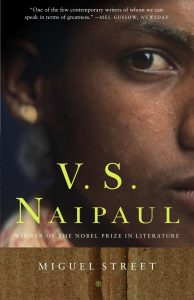
Miguel Street by V. S. Naipaul
Naipaul’s story collection about a cast of characters whose lives unfold on a fictional street on the Caribbean island of Trinidad was also a source of inspiration for the community I was creating in Halifax, Nova Scotia. How the characters in these stories attempt to overcome their economic status through their hopes about a variety of business endeavors, dreamed and real, from carpentry to shop keeping was particularly informative, showing both the constraints and possibilities of their lives.
JC: Naipaul creates a vibrant community, full of fascinating characters, as seen by its young narrator. His approach is objective, realistic, and yet mysterious. Take Bogart, a man who plays cards all day, then disappears for months at a time, heading off by ship to British Guiana, disappearing into the interior, running a brothel, returning each time to become more feared, and ultimately being jailed. When he’s questioned, Bogart clams up. Each time he returns his accent is more American. But his trajectory is not upward. Which Naipaul character did you find most intriguing?
JC: Getting to know the characters like Hat and Popo and Man-Man took me back to my childhood attending a segregated elementary school in Alabama. One of my earliest memories was in meeting the parents of my classmate and hearing the parents call the boy or girl in my class by a name very different than the one the teacher read when she called the roll. This was intriguing to me but not a surprise since, like the character Hat in Naipaul’s story, many of the adults in my community where I lived went by different names than the ones they were given at birth. Hearing the parents call the children by a different name than the teacher was not so much a surprise to me as it was a verification of a practice that occurred in my own extended family. Reading Miguel Street, I was drawn to characters like Popo and Man-Man because of their intriguing names, but each kept my attention because of the unique way in which they dealt with their challenging economic circumstances. While Popo, the would-be carpenter, considers himself a businessman of sorts, Man-Man addresses his impoverished circumstances through education and politics. Though some in the community may think Man-Man mad, he understands quite well the power of the ballot. His placement of himself on a poster asking for votes, and his scribbling of letters on the pavement to be seen by the school children may seem futile acts yet both demonstrate that like many in the community, he recognizes that there are options through which residents of the community may address their circumstances. In this way Man-Man is a teacher of sorts, passing on knowledge that enriches the lives of residents of the community, even if they do not at first recognize the value of his actions.
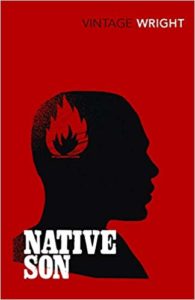
Native Son by Richard Wright
Native Son depicts a young black man, Bigger Thomas, whose reaction to his life of poverty and deprivation in 1930s inner city Chicago is an oversized rage and criminality that builds to a tragic end. Though the novel deals with grand themes of struggle, urban poverty, and aspiration in early twentieth century America, few writers have rendered the harsh circumstances that confounded and restricted the lives of urban black families during this early twentieth century with the power that Richard Wright brought to this novel.
JC: Which passages or sections most impress you?
JC: Early in the novel, when Bigger and his friend Gus meet outside a pool hall where they notice a plane high above. The scene unfolds like this:
They squinted at the tiny ribbon of unfolding vapor that spelled out the word USE . . . The place was so far away that at times the strong glare of the sun blanked it from sight.
“You can hardly see it,” Gus said.
“Looks like a little bird, Bigger breathed with childlike wonder.
“Them white boys sure can fly,” Gus said.
“Yes,” Bigger said, wistfully. “They get a chance to do everything.”
This passage hints at the jealousy Bigger has with what he understands to be benefits certain men have in the world because they are white. It also hints at the jealousy he feels about anyone he feels as living with greater means. While the scene demonstrates the frustration Bigger carries about his difficult circumstances, it is also a rare moment of unadorned innocence in what otherwise is a bleak narrative. The childlike innocence Bigger demonstrates in this scene makes the murders he commits later in the novel quite terrifying. But Wright is up to more than mere juxtaposition. This and other scenes demonstrated Wright’s capacity for digging deep into even the most distasteful of characters to present aspects of their personality that enliven them on the page.
*
· Previous entries in this series ·

